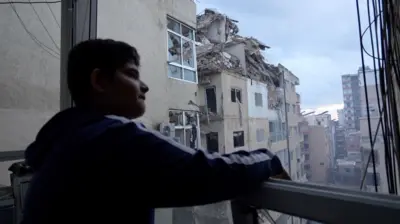We've updated our Privacy and Cookies Policy
We've made some important changes to our Privacy and Cookies Policy and we want you to know what this means for you and your data.
Ukraine thrown into war's bleak future as drones open new front
- Author, Quentin Sommerville
- Role, Lyptsi, north-eastern Ukraine
The black box sits on the army truck dashboard like a talisman, its tiny screen lighting up with warnings when Russian drones are above us. We are driving fast along a country road in the darkness near the front lines outside Kharkiv.
Like many in this war, the soldiers inside have come to revere the little cube they call "sugar"; it warns of the unseen dangers above.
On the vehicle’s roof are three mushroom-shaped antennas that make up separate drone-jamming equipment. The car emits an invisible aura of protection that will thwart some, but not all, of the Russian attack drones patrolling the skies above this battlefield.
"It has detected the Zala Lancet Russian drones," says Senior Lt Yevhenii, 53, from the front passenger seat, describing one of the most powerful long-range Russian drones and its targeting drone. "Is that why we’re driving so fast?" I ask, aware that the drone-jamming antenna is useless against a Lancet.
"We’re not a priority for them, but it’s still better not to slow down because it’s very dangerous," says Yevhenii, from the Khartia Brigade of Ukraine’s National Guard.
Top Stories
The jamming equipment blocks roughly 75% of frequencies that drones use to communicate with their operators, but some like the Lancet are difficult to block because they are entirely autonomous once their target has been marked. Because of the Lancet’s power, it tends to be used on larger targets, such as armoured vehicles or infantry positions, the Ukrainians say.
Almost none of this technology was here in Ukraine a year ago; now it is commonplace. Drones, which were once peripheral to the war, are a central component for both sides, alongside infantry and artillery as Ukraine struggles to hold back Russian advances.
Ukraine has been thrown into the bleak future of war, where within minutes individual soldiers, fast-moving vehicles and trench positions can be precisely targeted. Drones have civilians in their sights too: about 25 from Russia attacked Kharkiv on Tuesday night, although most were intercepted.
Ukraine's army is fighting back with its own drones, and there are dozens across this stretch of front line. One Ukrainian soldier tells me every day they kill 100 Russians.
The last images from drone cameras are usually of men panicking, their arms flailing, weapons firing before they are killed. The brigade’s 37-year-old drone commander, who goes by the call sign Aeneas, says that without shelter in a building there is little chance of survival - for Russians, and his men too.
"It's the new way or a new path in modern war. In 2022 it was only infantry war and today one half is only a war of drone, a battle between Russian drones and ours," he says.
The move to drone warfare is a combination of necessity and innovation. Drones are in plentiful supply, even though when armed they lack the explosive fire power of artillery.
Ukraine has consistently run short of artillery shells, and its allies have been slow to produce and supply them. But a Drone Coalition of Ukrainian allies has pledged to supply the country with a million drones this year.
Russia has made its own innovations on the battlefield too, using an older technology, and the village of Lyptsi, just six miles (10km) from the Russian border, has paid the price.
Top Stories
It was devastated by glide bombs - Soviet-era "dumb bombs" fitted with fins and a satellite guidance system. Some are as large as 3,000kg (6,600lbs) and, when launched from aircraft, glide onto Ukrainian infantry positions and towns to highly destructive effect.
One woman named Svitlana, who was driven out of Lyptsi by these attacks, told us: "Everything was exploding all around. Everything was burning. It was scary there. It was impossible to even get out of the cellar."
Aeneas takes us on a tour of his drone teams, embedded along the front line in Lyptsi. Every vehicle we encountered near there was fitted with drone-jamming equipment; but the jammer’s protection ends when you exit the vehicle.
It’s dangerous to be caught out in the open, so we follow Aeneas running across the rubble for cover.
Out of breath, we make it to the drone unit’s underground base beneath a ruined building, where we are introduced to two operators, Yakut and Petro. There are drones on every surface, next to a frying pan with their evening meal.
They get through many hundreds of drones in a month, as most are single-use and detonate on their target.
Their weapon of choice is the First Person View (FPV) drone, which carries a payload of between 1kg (2.2lbs) and 2kg of explosive, packed with shrapnel. The drones are modified off-the-shelf models which have cameras to send video back to their remote operators. "We call them celebration drones in Ukraine. They were used to film weddings and parties before the war," Aeneas says.
I watch on a screen in real time beside Yakut who is fixed in concentration flying a drone manually to a target, across open fields and woodland. "He knows every puddle, every tree in the area," Petro says.
The FPV drone approaches a building where a Russian soldier is believed to be hiding. It flies through an open window and detonates, the operator's screen turning to static as the signal is lost. At the same time, another drone team is targeting a Russian Tigr light-armoured vehicle and scores a direct hit, captured by a second surveillance drone that’s watching from above.
Top Stories
The men stay on these positions, flying missions day and night, for up to five days at a stretch and spend as little time outside as possible. Their biggest fear is glide bombs: one landed nearby earlier that week, and the whole building shook. What happens if there’s a direct hit? I ask Petro. "We die," he replies.
Aeneas shows me a recording from earlier in the week: a Russian soldier is caught in the open and the unit’s drone has him in its sights. The soldier notices it and runs for cover, hiding in a drainage culvert by the roadside. Slowly the drone lowers to its level, checking one side of the drainage pipe, then going around the other side, where the soldier is hiding. It detonates and the man is blown out, dying by the roadside. "He was divided into two parts," explains Aeneas.
The operators are cool and dispassionate, almost clinical in their targeting and killing. They are as far as three miles (5km) away from their targets, one step removed from the immediate blood and guts of the battlefield. But encountering these weapons on the frontline is nerve-wracking.
A few days later, after dark, at an infantry trench close to Russian positions, a unit commander tells me he believes the Ukrainians have the upper hand in drone warfare, the Russians the advantage with glide bombs.
Russia also has the advantage in drone numbers: six for every Ukrainian one, although the drone teams I was with say they have the technological edge and are quicker at finding ways to counter-attack and jam Russian drones.
The trench is in a wooded copse, surrounded by fields, a thick canopy of trees provides cover.
But as we are speaking a Russian FPV drone is detected and begins to move closer to the position. The few dim lights, mostly phone screens, are turned off in the trench, and the men sit silently as the drone’s approach gets louder. We hold our breath as it hovers overhead. For what seems like an age, no one dares move. But then the drone moves on, in search of another target.
The largest drone in the brigade’s arsenal is the Vampire, which with its six rotors is the size of a coffee table. Again we join Aeneas on another mission in Lyptsi after dark, under the sound of constant artillery fire, where we meet the heavy bomber team. They work to attach the bomb to the drone.
"[Weighing] 10kg (22lb), the Russians call this drone the Bogeyman," says Aeneas. Its payload is powerful enough to take out their intended target, a Russian command post, they say.
As the men work, a Russian drone makes a number of passes overhead: each time it does, the soldiers retreat into the basement, wait for the all-clear, then resume the assembly. As the drone takes off into the night in a cloud of dust, they watch its progress again from a second surveillance drone.
Just then, with barely any warning, we see on the drone’s thermal camera three Russian glide bombs detonating over the Ukrainian position, over a kilometre away. The shock waves are visible: seconds later they reach our location and the house around us shudders violently.
Ukraine’s allies know that by supporting the drone effort, they are helping the country’s cause, but it isn’t simply an act of charity.
The head of the British military, Admiral Sir Tony Radakin, has said that the UK’s armed forces can learn from Ukraine how to fight future wars. He said in a speech on Tuesday that he wants the Army to have "battalions of one-way attack drones".
Aeneas and his men know this. As we leave their position, a Russian drone returns and we drive off at speed into the darkness. In the truck he tells me: "No one is fighting war this way - they are learning from us. This will be the future war."
Follow Quentin
Top Stories
More to explore
Most read
Content is not available








